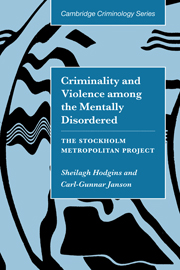Book contents
- Frontmatter
- Contents
- List of figures
- List of tables
- Preface
- Introduction
- Chapter 1 Research on the criminality and violence of the mentally ill
- Chapter 2 The longitudinal approach
- Chapter 3 Swedish society and Stockholm: the cohort and its context
- Chapter 4 Criminality
- Chapter 5 Explanations of the criminality of the mentally ill
- Chapter 6 Early and late-starters
- Chapter 7 Conclusion
- References
- Index
Chapter 6 - Early and late-starters
Published online by Cambridge University Press: 22 September 2009
- Frontmatter
- Contents
- List of figures
- List of tables
- Preface
- Introduction
- Chapter 1 Research on the criminality and violence of the mentally ill
- Chapter 2 The longitudinal approach
- Chapter 3 Swedish society and Stockholm: the cohort and its context
- Chapter 4 Criminality
- Chapter 5 Explanations of the criminality of the mentally ill
- Chapter 6 Early and late-starters
- Chapter 7 Conclusion
- References
- Index
Summary
As was noted in Chapter 4, some of the offenders who developed major mental disorders began offending in early adolescence and as was presented in Chapter 5, some of them had been identified even before that by the child welfare agency for substance abuse. Others who also developed a major mental disorder did not begin offending until adulthood. Among the offenders, the early-starters were defined as those who were convicted of their first offence before the age of eighteen, and the late-starters as those who were convicted of their first offence at or after the age of eighteen.
PREVALENCE OF EARLY AND LATE-START OFFENDERS
The prevalence of the early and late-start offenders is presented in Table 6.1. The increased prevalence of offenders among both the males and females with major mental disorders as compared to the non-disordered subjects is reflected in greater proportions of both early and late-starters. However, there is a significant gender difference, both among the disordered and the non-disordered. Among the males, the proportions of early-start offenders are greater than the proportions of late-start offenders. The reverse is true among the females.
COMPARISONS OF OFFENDING OF THE EARLY AND LATE-START OFFENDERS
Males
Table 6.2 presents comparisons of the proportions of early and late-start male offenders convicted of non-violent and violent offences. Consider first the men with major mental disorders. Half of the early-starters as compared to 13% of the late-starters had been convicted of eleven or more non-violent offences.
- Type
- Chapter
- Information
- Criminality and Violence among the Mentally DisorderedThe Stockholm Metropolitan Project, pp. 141 - 179Publisher: Cambridge University PressPrint publication year: 2002

